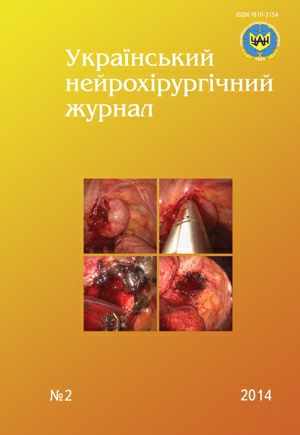Microsurgical single-stage repair of pericallosal artery multiple aneurysms
DOI:
https://doi.org/10.25305/unj.51355Keywords:
pericallosal artery, arterial aneurysm, inter-hemisphere fissureAbstract
Nowadays there are two methods of surgical treatment of brain arterial aneurysms (AA): microsurgical transcranial and endovascular. Method selection is based on AA morphological, anatomical and topographical characteristics and estimation of patients’ condition.
Aneurysms of pericallosal arteries (PCA) are revealed in 2–6% cases of all intracranial AA.
In 15% cases in the structure of multiple AA of distal segments of anterior cerebral artery aneurysms are located only on the A3 segment of pericallosal artery, among them 71% — on the opposite side, 29% — on the same side.
An observation of multiple aneurysms of PCA A3 segment transcranial single-stage microsurgical turn off from the blood flow is given. Aneurysms were located on opposite arteries, two — on the right, and one — on the left side. Microsurgical approach to PCA in inter-hemisphere fissure was used, AA were clipped.
The patient was operated urgently due to her critical condition.
Complex clinical and instrumental examination allowed to choose method of surgical treatment (transcranial microsurgical), to determine an optimal surgical tactics (single-stage turn off) and to plan surgery.
References
1. Miyazawa N, Nukui H, Yagi S et al. Statistical Analysis of Factors Affecting the Outcome of Patients with Ruptured Distal Anterior Cerebral Artery Aneurysms. Acta Neurochirurgica. 2000;142(11):1241-1246. [CrossRef]
2. Otani N, Takasato Y, Masaoka H et al. Clinical features and surgical outcomes of ruptured distal anterior cerebral artery aneurysms in 20 consecutively managed patients. Journal of Clinical Neuroscience. 2009;16(6):802-806. [CrossRef]
3. Hashimoto H, Iida J, Hironaka Y, Okada M, Sakaki T. Use of spiral computerized tomography angiography inpatients with subarachnoid hemorrhage in whom subtraction angiography did notreveal cerebral aneurysms. J Neurosurg. 2000 Feb;92(2):278-83. [PubMed]
4. Gelfenbeyn M, Natarajan S, Sekhar L. LARGE DISTAL ANTERIOR CEREBRAL ARTERY ANEURYSM TREATED WITH RESECTION AND INTERPOSITION GRAFT. Neurosurgery. 2009;64(5):E1008-E1009. [CrossRef]
5. Rhoton A. Aneurysms. Neurosurgery. 2002;51(SUPPLEMENT 1):S1-121-S1-158. [CrossRef]
6. Ugur H, Kahilogullari G, Esmer A et al. A neurosurgical view of anatomical variations of the distal anterior cerebral artery: an anatomical study. Journal of Neurosurgery. 2006;104(2):278-284. [CrossRef]
7. Lehecka M, Dashti R, Hernesniemi J et al. Microneurosurgical management of aneurysms at A3 segment of anterior cerebral artery. Surgical Neurology. 2008;70(2):135-151. [CrossRef]
8. Davies J, Tawk R, Lawton M. The Contralateral Transcingulate Approach. Neurosurgery. 2012;71:ons4-ons14. [CrossRef]
9. Carvi y Nievas M. The influence of configuration and location of ruptured distal cerebral anterior artery aneurysms on their treatment modality and results: analysis of our casuistry and literature review. Neurological Research. 2010;32(1):73-81. [CrossRef]
10. Joshua S, Nayak S, Pare V, Ashok, Sebastian R. Unruptured Intracranial Aneurysm Involving the Distal Anterior Cerebral Artery: A Cadaveric Study. Journal of Case Reports. 2013;3(1):5-9. [CrossRef]
Downloads
Published
How to Cite
Issue
Section
License
Copyright (c) 2014 Orest Tsimeyko, Andriy Sydorak, Igor Tysh

This work is licensed under a Creative Commons Attribution 4.0 International License.
Ukrainian Neurosurgical Journal abides by the CREATIVE COMMONS copyright rights and permissions for open access journals.
Authors, who are published in this Journal, agree to the following conditions:
1. The authors reserve the right to authorship of the work and pass the first publication right of this work to the Journal under the terms of Creative Commons Attribution License, which allows others to freely distribute the published research with the obligatory reference to the authors of the original work and the first publication of the work in this Journal.
2. The authors have the right to conclude separate supplement agreements that relate to non-exclusive work distribution in the form of which it has been published by the Journal (for example, to upload the work to the online storage of the Journal or publish it as part of a monograph), provided that the reference to the first publication of the work in this Journal is included.









